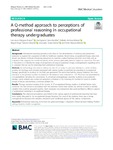Mostrar o rexistro simple do ítem
A Q-Method approach to perceptions of professional reasoning in occupational therapy undergraduates
| dc.contributor.author | Márquez Álvarez, Luis Javier | |
| dc.contributor.author | Calvo-Arenillas, José-Ignacio | |
| dc.contributor.author | Jiménez Arberas, Estíbaliz | |
| dc.contributor.author | Talavera Valverde, Miguel Ángel | |
| dc.contributor.author | Souto Gómez, Ana Isabel | |
| dc.contributor.author | Moruno Miralles, Pedro | |
| dc.date.accessioned | 2021-07-01T08:14:13Z | |
| dc.date.available | 2021-07-01T08:14:13Z | |
| dc.date.issued | 2021-05-07 | |
| dc.identifier.citation | Márquez-Álvarez LJ, Calvo-Arenillas JI, Jiménez-Arberas E, Talavera-Valverde MÁ, Souto-Gómez AI, Moruno-Miralles P. A Q-Method approach to perceptions of professional reasoning in occupational therapy undergraduates. BMC Med Educ. 2021 May 7;21(1):264. | es_ES |
| dc.identifier.issn | 1472-6920 | |
| dc.identifier.uri | http://hdl.handle.net/2183/28148 | |
| dc.description.abstract | [Abstract] Background. Professional reasoning provides a firm basis for the development of teaching and assessment strategies to support the acquisition of skills by healthcare students. Nevertheless, occupational therapy educators should use diverse methods of learning assessment to examine student learning outcomes more fully with an evaluation that supports the overall complexity of the process, particularly learners’ subjective experience. The aim of this article is to identify the range of perspectives among occupational therapy undergraduates regarding terms or concepts that are key for improving their professional reasoning. Methods. Q-methodology was used to address the aim of the study. A concourse relating to a series of ideas, phrases, terminology, and concepts associated with various studies on professional reasoning in occupational therapy, specifically on students in this field, was generated. The terms that had the clearest evidence, the most relevance or the greatest number of citations in the literature were collected (n = 37). The P-set was assembled by non-probabilistic sampling for convenience. It comprised undergraduate university students in occupational therapy. Factor analysis was conducted using Ken-Q Analysis v.1.0.6, reducing the number of Q-sets to smaller groups of factors representing a common perspective. Results. Through statistical analysis of the Q-sorts of 37 occupational therapy students, 8 default factors were identified. The four factors in accordance with the selection criteria were rotated by varimax rotation to identify variables that could be grouped together. Each viewpoint was interpreted, discussed and liked to different aspects of professional reasoning in occupational therapy. Conclusions. The observed perceptions were linked to the various aspects of professional reasoning that have been widely discussed in the occupational therapy literature. For most of the students, there was a strong correspondence between the narrative, interactive and conditional aspects of the various components. | es_ES |
| dc.language.iso | eng | es_ES |
| dc.publisher | Springer Nature | es_ES |
| dc.relation.uri | https://doi.org/10.1186/s12909-021-02710-y | es_ES |
| dc.rights | Creative Commons Attribution 4.0 International License (CC-BY 4.0) | es_ES |
| dc.rights.uri | http://creativecommons.org/licenses/by/4.0/ | * |
| dc.subject | Professional reasoning | es_ES |
| dc.subject | Q-method | es_ES |
| dc.subject | Occupational therapy / education | es_ES |
| dc.subject | Clinical decision-making | es_ES |
| dc.subject | Problem solving | es_ES |
| dc.subject | Students, health occupations | es_ES |
| dc.title | A Q-Method approach to perceptions of professional reasoning in occupational therapy undergraduates | es_ES |
| dc.type | info:eu-repo/semantics/article | es_ES |
| dc.rights.access | info:eu-repo/semantics/openAccess | es_ES |
| UDC.journalTitle | BMC Medical Education | es_ES |
| UDC.volume | 21 | es_ES |
| UDC.startPage | 264 | es_ES |
| dc.identifier.doi | 10.1186/s12909-021-02710-y |






